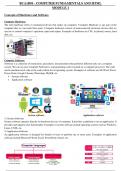Summary
Summary Computer fundamentals & HTML module 1
- Course
- Institution
In the BSc Computer Science first-year Module 1, "Computer Fundamentals and HTML," students are introduced to the foundational concepts of computing and web development. This module covers the basic principles of computer systems, including hardware components, software, and operating systems. Stud...
[Show more]



